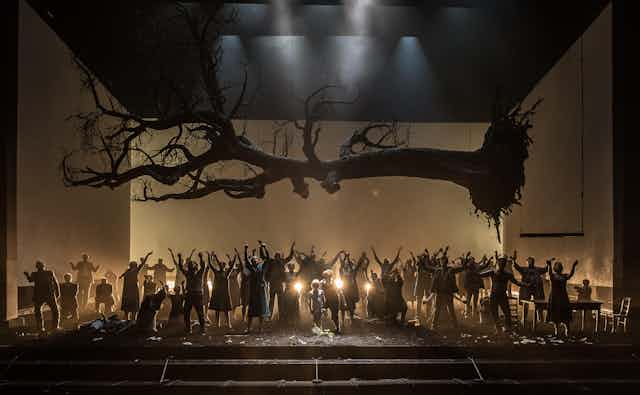A vitriolic debate has broken out concerning the latest production at London’s Royal Opera House. On its opening night, Damiano Michieletto’s production of Gioachino Rossini’s opera Guillaume Tell was booed by audience members, who were enraged at its graphic portrayal of sexual violence.
The audience’s condemnation of the “gratuitous” violence was followed by some negative reviews. But soon, commentators fought back, arguing that the role of art is to push the boundaries and to elicit shocked reac tions. My own interest in this debate started on Twitter, scrolling through #ROHTell. One user complained about the violence shown on stage, suggesting violence in return: “heads should roll”.
Violence on stage – particularly the operatic stage – is certainly nothing new. Murders, rapes and other violent scenes are part of many opera plots. Verdi’s Don Carlos is burnt at the stake; Rigoletto’s daughter Gilda is stabbed on stage and dies in his arms; Francis Poulenc composed a guillotine beheading dozens of Carmelite nuns into his score. So why did this particular portrayal of violence provoke such a strong reaction from the audience, and gain such a lot of media attention?
Preservation or innovation?
Some context about the position of a publicly subsidised opera company might be useful: the core repertoire is mostly over a hundred years old and quite limited. Although opera companies are often keen to introduce lesser-known works into the repertoire, they are mostly encouraged to programme familiar works, in line with audience expectation and economic necessity.
This means a diet of Bohèmes, Magic Flutes, Traviatas and Butterflies, furnished with a few lesser known works by well-known composers (of which Guillaume Tell is one) and even fewer new or commissioned operas. Companies must satisfy both the “museum” and the “art gallery” demands made on an opera house. They need to both preserve and innovate, appealing to both reactionary and progressive audiences.
The uproar over the Royal Opera House production of Tell has clearly demonstrated these conflicting demands. The traditionalist, “true to the piece” camp demands that opera be shown in its historical setting. Alternatively, it is suggested that with only a limited number of works, we cannot keep repeating ourselves: classical works have to be supplemented and contrasted with contemporary scenography and conceptual thought. The art form – like Tell’s dynamic overture – has to keep moving forward.
The self-proclaimed sufferers of “modern” opera productions show an almost baffling sense of self-confidence when they assert what is right and wrong. Even after 30 years of opera experience, I find this incomprehensible. Taste is not categorical, and neither are opinions: there is no correct way to direct an opera – there is only convention. To argue that it’s all in the music, or that the composer’s intentions are clear, is to attempt to turn opinion into fact.
Music does not inherently “mean” anything, though it can suggest certain associations or evoke certain feelings. These may strike us as obvious, because we become conditioned to certain aesthetic rules of signification. For example, if ballet music is played in an opera, we expect dancers and choreography. If instead we see a chilling display of violence – seemingly out of step with balletic associations – this is likely to clash with our expectations and disturb us. But will also open our eyes to alternatives avenues of interpretation.
And as for stage directions, well, if we followed Richard Wagner’s, for example, any house taking on his operas would probably be bankrupt and derided for producing kitsch. Times change, tastes and production styles evolve – and not always harmoniously.
A disturbing truth
But the recent Tell performance has seemingly crossed a threshold. During ballet music in the fourth act, the stage directions state that Gesler’s occupying soldiers force the local women to dance. In Damiano Michielleto’s production, a female performer was shown to be sexually molested by a group of soldiers. She had her clothes removed and was laid on a table, suggesting a gang rape.
Even writing this makes me very uncomfortable, and I have in the past reacted with shock and distress to rape scenes on the stage or screen. Those who protested at the Royal Opera House were obviously similarly affected. But their emotion then turned to anger, because they felt they should not have been subjected to this scene.
According to Aristotle, extreme actions on stage serve the function of creating feelings of pity and fear: pity for the victim whose plight we see, and fear that the same plight might befall us. In the Royal Opera House’s auditorium, the protesters felt that they were the sufferers, leading them to label the scene unnecessary, and its violence “gratuitous”. But one viewer’s gratuitous will be another’s cutting edge and relevant. The aggression of the booers drowned out the music, and they were vociferously criticised by other audience members. Instead of kindling empathy for the victim, the performative aggression on stage was drowned out by real aggression in the auditorium.
We cannot control reactions to art – that would be as wrong as demanding that “heads should roll” over productions we don’t approve of. To me, booing can turn into a form of bullying, and I feel more strongly opposed to the booing of performers than of creative teams. Yet one of the performers in the Royal Opera Houses’ controversial production said that, despite the turmoil, he was happy that people have shown strong opinions.
This goes to show that art’s worst enemy is not hostility, but apathy. One of art’s purposes is to prompt us to think about how we can change our desensitisation to human suffering. If staged violence disturbs and shocks us, it might just be capable of propelling us into action, to counter real violence.
For an alternative take on the William Tell controversy, click here.

